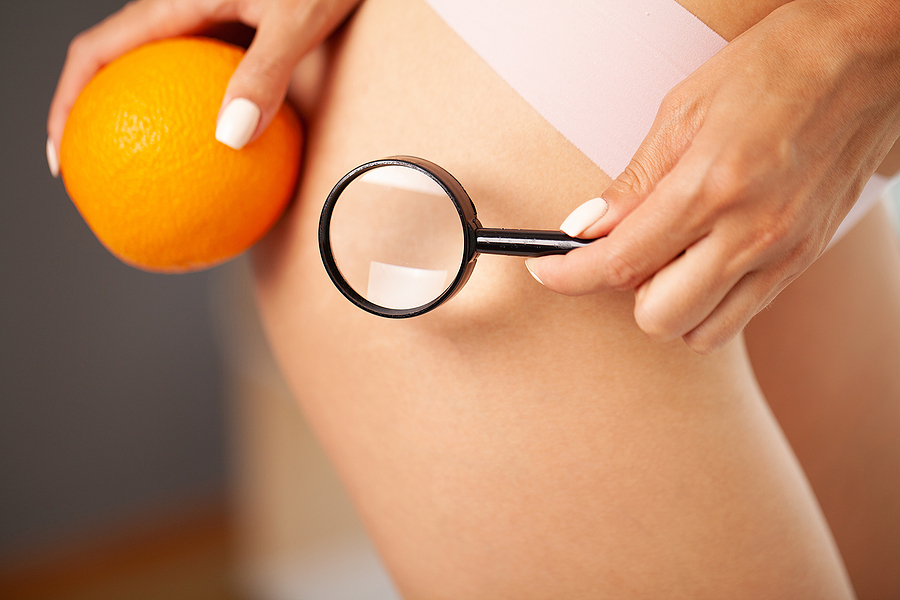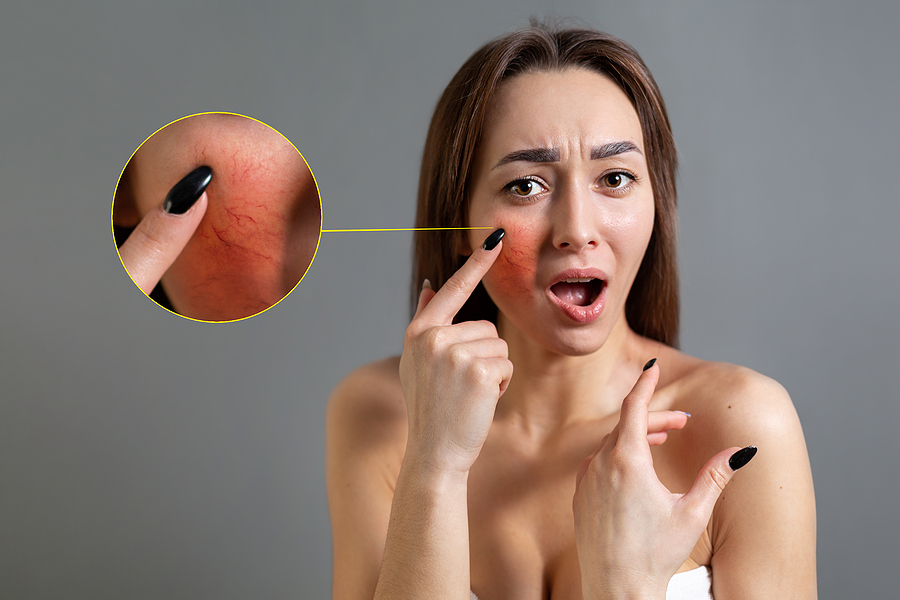Updated 06/16/2021
When shopping with my friend Jenna, I heard a wail of despair coming from her changing room. I asked what was wrong and she said “I can’t wear a bathing suit this year. Just look at my skin — it’s all dimpled and bumpy. I don’t know how, this much cellulite built up over the winter.”
Jenna’s anxiety about her bumpy, dimpled skin is something I hear from patients a lot. Often, like Jenna, they refuse to wear shorts or a bathing suit – even when it’s 85 degrees outside! They just can’t bear the thought of walking around with that textured skin showing.
So many of these women tell me they’ve tried everything – wraps, creams, and even electrical stimulation – to reduce the cellulite and regain their formerly smooth and evenly plump skin.
Does that sound like you? Are you avoiding wearing shorts or a bathing suit? Are you afraid you’ll never be comfortable in them again?
You don’t have to give in and cover up! Let’s take a look at where cellulite comes from and the role hormones play in the process. Then, I’ll give you 8 quick tips to help manage cellulite so you feel confident in whatever you choose to wear!
What causes cellulite?
Cellulite is almost exclusively a female concern – the anatomy of a woman’s skin is different than a man’s and cellulite is primarily about estrogen. As estrogen is released into a woman’s body, fluid builds up in fatty tissues. And women have more fatty tissue than men – particularly throughout the thighs and hips.
Additionally, the very hormone which helps us relax during pregnancy decreases production of collagen, which is the protein which helps keep skin elastic and strong. When elasticity decreases, there is a greater likelihood that cellulite will develop.
Cellulite is located in the subsurface, or subcutaneous, layer of the skin. It is made up of connective tissue and fat cells known as the septa. Cellulite forms when the structural support of the skin starts to collapse and the fat cells push through it – that’s what causes the ‘dimpled’ look that so many women would like to do away with.
How does cellulite form?
Like most things in life, there isn’t a quick fix for erasing cellulite. That doesn’t mean, however, that women are doomed to a life of covering up. There are things you can do to reduce the appearance of cellulite and be comfortable in your own skin again. The first step is understanding how cellulite forms and what you can do to support your body’s proper function to help prevent cellulite from forming.
Our lymphatic system plays a critical role in the development of cellulite. The septa becomes stiff because of decreased lymph and blood circulation to the subcutaneous layer of skin. The tissue weakens and the decrease in lymph drainage causes the fluids which should carry away waste to be trapped. The septa then becomes fibrous and tightens even more on the underlying fat cells. The decreased circulation also weakens capillaries and veins, causing the surrounding tissue to harden. Blood reroutes around the cellulite area and the septa fibers continue to thicken and even more fat continues to be deposited. The fats and toxins won’t be removed because of the poor circulation.
That means, then, that a healthy lymph system is essential in stopping the formation and breaking the cellulite building cycle.
Our sweat glands, kidneys, liver and lymph system are all critical to ridding our bodies of toxins. Toxic build-up is the primary cause of the stagnant lymph, which is at the crux of cellulite. When your body is overburdened with chemicals, additives, and other toxins, these organs are unable to keep up. If you think about these organs as screens or filters, it makes sense that they would need to be cleaned regularly in order to work efficiently.
Although your body has a natural cleansing process, this build up is why I recommend that my patients ‘detox’ two to three times a year. This gentle process gives you a little boost, allowing these organs to clean up and jump start to keep you healthy!
The role of hormones for healthy skin
Well balanced hormones are essential for a healthy body — including the health of your skin. During periods of great hormonal fluctuation, like pregnancy or perimenopause, women may experience an increase in cellulite. We’ve known for many years that estrogen plays a role in keeping skin elastic and firm, due to the role it plays in increasing the formation of collagen.
When your hormones are not balanced, the walls of your veins and lymph vessels are less resilient – and they are not as efficient in removing toxins. This weakness also causes lymph flow and blood to stagnate which contributes to the stiffening of the septa.
Progesterone and human growth hormone (hGH) are also important hormones when looking at skin health. Progesterone, when used in a natural form, converts to other hormones (including estrogen), if needed. Research has shown that hGH is an important factor in the development, maintenance and repair of skin.
If your hormones are out of balance, there are many strategies you can use to restore balance naturally. Hormone replacement therapy can be controversial – especially around the use of hGH. I always recommend doing some research, and working with a trusted healthcare practitioner, before using any type of hormone replacement therapy.
8 Tips to Reduce Cellulite
Cellulite doesn’t happen spontaneously or in isolation. Your body’s systems are all connected, and the cellulite you see is a symptom of something going on in your body. It’s important to clear your body of toxins regularly, feed your body what it needs and be aware of natural ways to keep your hormones balanced.
I regularly recommend the following 8 tips to patients because women report great success when they try them.
1. Be aware of toxins and limit your exposure
There are so many things that women put in their bodies regularly without a second thought — but that’s a mistake! Preservatives, chemicals, additives, alcohol and caffeine all test your lymph system. Sugar is a major culprit as well, and it’s best to eliminate it from your diet as much as possible. Sugar interferes with Vitamin C metabolism and vitamin C is critical to the formation of elastin and collagen.
2. Try a detox program
Sometimes, your body needs a break and a little help cleaning things out. There are a multitude of detox food plans available. You may want to consider one based on Ayurvedic principles. I’ll often recommend a two week detox plan. While some women find it challenging to follow a strict protocol, most report feeling fantastic once they’ve completed it.
3. Breathe!
Yes, of course you are breathing all the time, but deep, intentional breathing helps lymphatic flow – and it helps you relax. Find time to focus on taking deep, cleansing breaths several times a day. I often suggest taking advantage of the time you spend waiting at stop lights or in lines to be mindful about your breathing.
4. Give your body the support it needs
Consider a high-quality multivitamin, like my Multi Essentials formula. While eating well is the most important factor, we often can’t get all of the nutrients we need from the foods we eat. That’s because farming and processing practices have reduced the nutritional values of our foods – even if we’re choosing whole fruits and vegetables! A daily multivitamin is an easy way to close the gap between what our body needs and the nutrients we are able to consume on a daily basis.
5. Don’t skip the exercise
Your body needs to move to stay healthy! Regular exercise helps increase muscle tone and burn fat. Both help to reduce the appearance of cellulite.
6. Practice lymphatic massage
Gentle massage can help drain and increase your lymphatic fluid. Many professional massage therapists offer lymphatic drainage massages, but you don’t have to commit to regular professional massages. You can familiarize yourself with the gentle finger movements that create pressure to move lymph fluid through your nodes and vessels and do it yourself.
7. Manage your stress
Chronic stress is at the root of so many healthy issues, mainly due to the high levels of cortisol that result from constant exposure to stressors. When our bodies are stressed, blood is directed away from the skin, affecting circulation and decreasing the nutrients being delivered to our skin. Increased cortisol tells the body to store fat which contributes to cellulite.
That’s why finding ways to reduce and manage stress is critical. There’s no one stress-relieving strategy that works for everyone. But one great tip is to find something you love, and do it every day!
8. Massage affected areas gently
When cellulite does form, you don’t have to assume you’re stuck with it forever. Gently massage areas of cellulite in a circular motion. This will help break down fat and toxins and increase blood flow to the area.
Free yourself from limitations
Cellulite is such a widespread issue — in fact, statistics say that between 80 and 90 percent of women will develop cellulite at some point in their lives.
Many women feel that cellulite is their destiny – they may have family members with it or they’ve been told that cellulite is just to be accepted. That’s what Jenna thought – but I assured her that it didn’t have to be true. There are things you can do to prevent or reduce the appearance of cellulite.
Raising your awareness of the process that contributes toward cellulite development can help you begin to support your all-important lymph system. And that just might lead to the winning combination to help you diminish or alleviate cellulite and hit the beach free from worry about the state of your skin!






